Young carers: review of research and data
Paper discussing the data and evidence on young carers and young adult carers in Scotland.
2. Who are the young carers in Scotland?
Introduction
This chapter contains demographic analysis of young carers including: age; gender; ethnicity; deprivation; geographical location; and also discusses the nature of care-giving duties. In general the data on young carers and young adult carers is a very similar picture so they are reported as one group.
Key points:
- The majority of young carers are older young people.
- Data suggests, as they get older, more children and young people provide a few hours caring per week.
- A larger proportion of girls and young women are carers and a majority of young carers and young adult carers are female.
- Evidence suggests that female young carers are more likely than male young carers to carry out domestic tasks and to provide intimate care.
- There are more young carers in the most deprived areas and they undertake more hours of care.
- Research suggests that young carers in rural areas carry out similar caring tasks but may face additional challenges such as more dispersed facilities and services.
- Nearly one quarter (22%; 8328) of young carers aged 4-24 (who are more likely to be young adult carers) provided 35 hours or more care per week.
- The nature of caregiving tasks varies significantly according to the health condition(s) experienced by the cared-for person.
2.1 Age
Census and SHeS data suggests that as children become older, more of them regularly provide a few hours caring [4] . Scotland's Census 2011 shows that the number of young people providing care increases with age: from 157 (0.28%) at age 5, to 2,996 at age 18 (4.4% of 18 year olds). The percentage decreases slightly at 19/20 and there is then a slight increase in the proportion of young carers in their early 20s (4.6% of 23 years olds).
Figure 1: % of population providing care, by single year of age
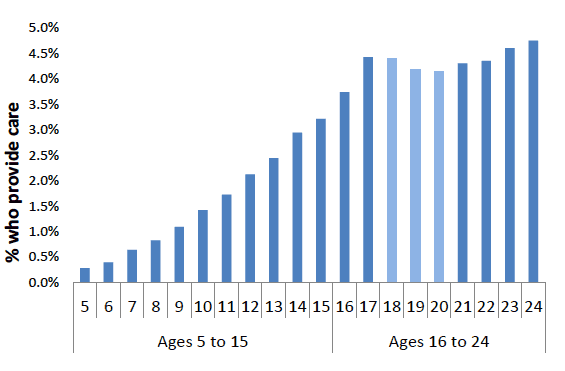
The majority of young carers are older young people;
- 53% are aged 13-15
- 30% are aged 10-12
- 14% are aged 7-9
- 4% are aged 4-6.
The reason for the fall in the number of young carers after the age of 18 is due in part to completion of universal schooling and moving to employment, further or higher education. Research indicates that some young carers move away from home and reduce their caring, whilst others retain their caring role. At the other end of the age range, a small group of children under five are known to provide care. [5]
2.2 Gender
Both young women and men are carers but a majority of young carers and young adult carers are female:
- 55% of young carers are female and 45% are male
- 3.2% of young women are carers and 2.5% of males
Research has also found that found that girls are more involved in caring tasks - particularly as they get older (Dearden & Becker, 2004, p. 3).
There is limited evidence which focuses on differential experiences of caring due to gender, but we know that gender differences impact upon the type of care work undertaken by young people. A survey of young carers in contact with support services in the UK (Dearden & Becker, 2004) found that 85% of female young carers carried out domestic tasks, compared to 69% of boys. Furthermore, they established that almost twice as many female young carers in the sample carried out intimate care compared to male young carers.
Table 1: Caring tasks by age and gender
| Caring Task | Gender | Age 5-10 | Age 11-15 | Age 16-18 |
|---|---|---|---|---|
| Domestic | Boys | 52% | 67% | 69% |
| Girls | 60% | 77% | 85% | |
| % difference | +8% | +10% | +26% | |
| Intimate | Boys | 11% | 15% | 17% |
| Girls | 13% | 22% | 32% | |
| % difference | +2% | +7% | +15% |
Table adapted from Dearden and Becker (2004, p. 9)
Eley's small qualitative study (2004, p. 68) found that boys had different pressures in their caring roles compared to girls. One boy in her study explains: "I'd be shouting my head off [to my brother/sister] saying get ready, get your school bag ready and get your breakfast." In this instance, the boy was expected to adopt a disciplinary role as part of his caring duties.
From the Census data and in various research studies, it is apparent that female young carers report that they have poorer wellbeing compared to young male carers. In the Census data, the difference is particularly pronounced in relation to the 16-24 year old age group. Research has found that young female carers were more likely to report problems and worries compared to young male carers (Cree, 2003, p. 306). A further small-scale study (Hamilton & Adamson, 2013, p. 112) found that young men reported higher levels of satisfaction with their mental health compared to young women. They note that half of the females in the study rated their mental health as 4 or below out of 10 (female total in sample n=14, age 7-17). Young carer's wellbeing is discussed further in Chapter 4.
2.3 Ethnicity
According to Scotland's 2011 Census, of all 4-24 year olds; 84% are white Scottish; 6% are white other British and 10% are from other ethnic groups. The proportion that are young carers and young adult carers is similar; 3% white Scottish and 2% others.
Although the numbers are small, there is a variation according to individual ethnic groups. The highest prevalence is 5% of white gypsy/traveller young people, followed by 4% of Pakistani, Scottish Pakistani or British Pakistani young people.
Figure 2: % of young people in different ethnic groups providing care
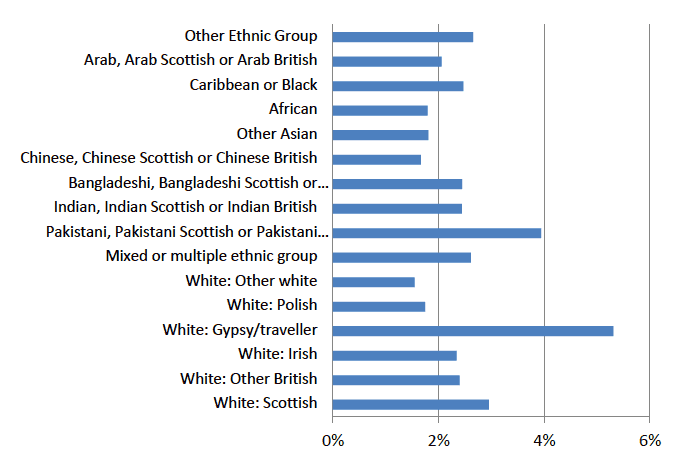
The small numbers do not allow for further analysis by ethnicity in Scotland. There is also a lack of research in relation to the specific experiences of young carers from black and minority ethnic ( BME) communities. Jones et al (2004, p. 11) argue that young carer research has focussed on the experiences of white young carers, and thus there are many assumptions and unfounded statements about the needs and experiences of BME young carers. Their small-scale study investigated the circumstances, experiences and needs of black young carers and their families in Manchester. They found that the families in the study were largely hidden to agencies, many of the disabled parents did not receive any services and many of the young carers in the study did not relate well to the term 'young carer.' However, it is difficult to know how far such findings can be generalised to Scotland.
2.4 Geographical location and deprivation
There are young carers and young adult carers across Scotland. Higher proportions of young people have caring responsibilities in areas of higher deprivation and lower income. Living with a disability or long-term health condition is often associated with living in poverty, being unemployed or living in relative income poverty.
Higher rates of caring by young people are found in areas of greater deprivation and amongst groups with lower incomes. The Census data shows that young people in the most deprived areas provide more care than in wealthier areas. [6] In the most deprived areas close to 4% of young people provide unpaid care and this gradually drops to just 2% in the least deprived.
Figure 3: % of people aged 4 to 24 providing care, by SIMD Quintile
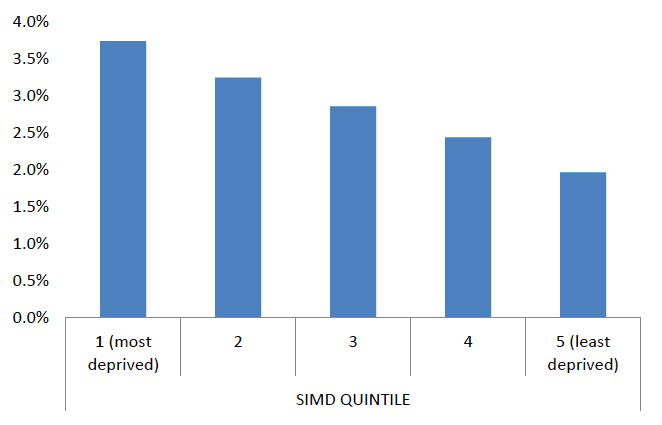
The Census data also shows that young carers living in the most deprived areas are the most likely to be providing more than 35 hours of care per week. This trend is also the same for adult carers (Scottish Government, 2015, p. 23).
Figure 4: Hours of care per week provided by carers aged 4 to 24 by SIMD Quintile
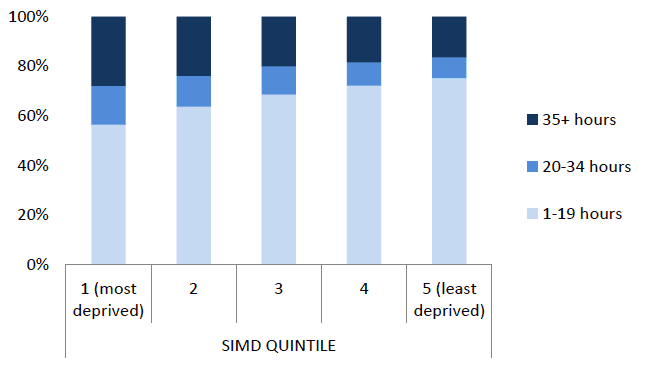
Whilst almost 30% of young carers care for over 35 hours in the most deprived areas, this is less than 20% in the least deprived areas. The pattern is the same for both the young carers group and young adult carers.
There is a consensus within the literature that young carers are more likely to live in a deprived area, have a low socio-economic status and be affected by poverty (Banks, et al., 2002, p. 807) (Barry, 2011, p. 524) ( SCIE, 2005). The Children's Society (2013, p. 5) found that the average annual income for families with a young carer is £5000 less than families who do not have a young carer. Children in families living with at least one disabled member are more likely to be living in poverty (21%); compared to children in families with no disabled member (16%) (Department for Work and Pensions, 2014). Research tells us that young carers are more common in families with unemployed parents or low incomes ( SCIE, 2005, p. 3) and this is also shown in the census data.
Figure 5: 4-15 year olds who provide unpaid care, by how many adults in their household are in employment
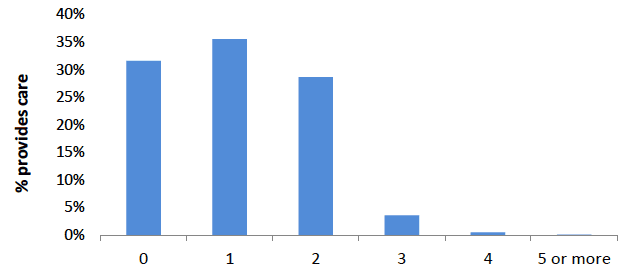
It is very difficult to separate the impact of caring from the impacts of unemployment, poverty, poor housing and low socio-economic status. This is a persistent problem which features in the young carer literature, shared by a number of researchers ( e.g. (Newman, 2002); (Cree, 2003, p. 305). Studies which do not have control groups have been criticised by the likes of Olsen & Parker (1997, p. 125) on this basis. A small number of studies comparing carers and non-carers provide important findings (Warren, 2007) (Lloyd, 2013).
Glasgow and West Dunbartonshire have the highest proportion of young carers by local authority area.
Figure 6: % of people aged 4-24 providing care, by Local Authority
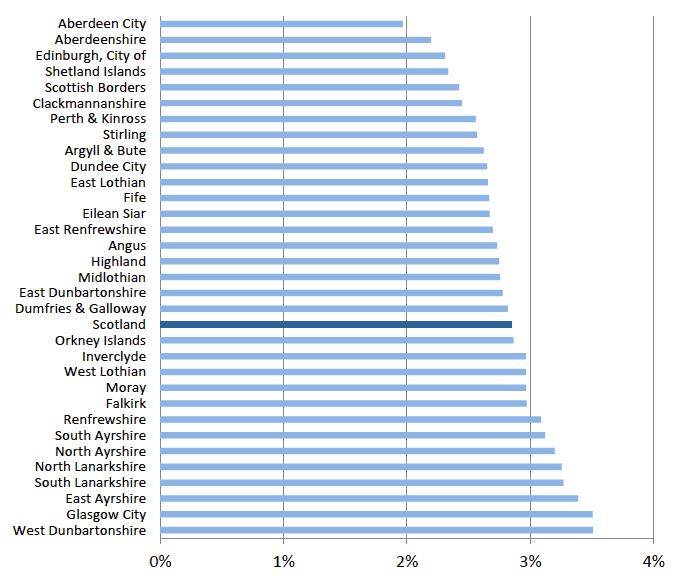
There is a slightly higher proportion of young people caring in urban than rural areas, although the difference is minimal.
Figure 7: % of people aged 4 to 24 providing care, by urban/rural split
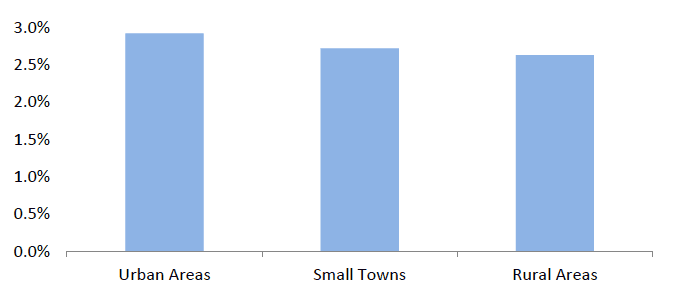
Evidence suggests that residing in a rural area brings additional challenges for young carers, and could serve to exacerbate the risk of social exclusion. Living in a rural area means that there are fewer facilities or services nearby for young people (Butler & Astbury, 2004, p. 297) (Commission for Rural Communities, 2010, p. 3). Due to the extra expense incurred in providing community care services in sparsely populated areas, there is not much flexibility or choice in the way in which services are delivered (Commission for Rural Communities, 2010, p. 10). In some circumstances, this may bring added duties for young carers. The Commission for Rural Communities (2010, p. 8) found that many of the young people in their study felt it was difficult to participate in the labour market, which had an impact on their economic wellbeing. However, the caring tasks carried out by children and young people are the same, whether in a rural or urban area (Frank, 1995).
2.5 The Nature of Caregiving Duties
Hours of Care Provided
The Census indicates whether the number of weekly hours of care provided was 1-19 hours; 20-34 hours and 35+ hours per week. Nearly one quarter (22%; 8328) of young carers aged 4-24 provided 35 hours or more care per week. Within this, 26% (7000) of young adult carers aged 16-24 and 13% (1328) young carers provide over 35 hours care. Around two thirds of young carers and young adult carers (66%) provide care for between one and 19 hours per week. This is a higher proportion than adult carers, 56% of adult carers provide this amount of care weekly.
Figure 8: Number of unpaid carers, by single year of age and hours of care
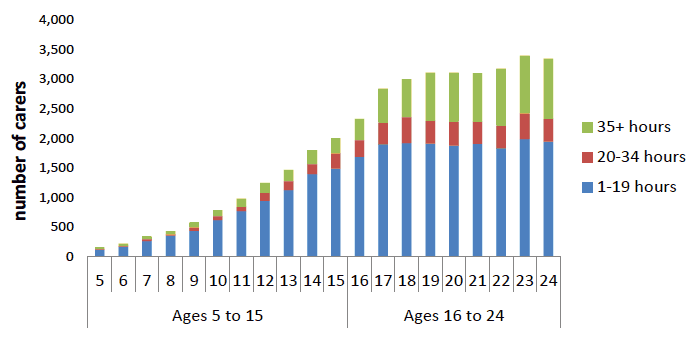
The majority of young carers provide care for 1-19 hours per week. This is a relatively large category, and it may not effectively capture lower levels of care (Scottish Government, 2015). It is notable that young adult carers are much more likely than child carers to provide over 35 hours of care per week. This is consistent with research findings which suggest that intensity of caring increases with age (Dearden & Becker, 2004, p. 3).
Caregiving tasks
The nature of caregiving tasks varies significantly according to the condition(s) experienced by the cared-for person (Lloyd, 2013, p. 68). For example, those caring for a person with a disability are much more likely to provide intimate care, and those caring for people with a mental health problem are much more likely to provide emotional care (Dearden & Becker, 2004, p. 8).
Historically there has been some debate about how much young carers actually differ in terms of their daily tasks compared to children from other households (Olsen, 1996, p. 44). This debate arose mainly due to a lack of evidence which compared the experiences of young carers and young non-carers of the same age (Olsen & Parker, 1997, p. 125). It is also the case that not all young people in households with people with care needs will be young carers.
Warren (2007) addressed this debate and gap in research by carrying out a study which compared the tasks that child carers and child non-carers undertook in the home. This was an extensive study involving structured interviews with 390 children from one local authority area. Warren (2007, p. 143) found that the 'nature, frequency and time spent by young carers each week on domestic and caring tasks differs from that of other children and young people in the general population.' It was also found, not surprisingly, that intimate care tasks most clearly distinguish young carers from peers who do not have a caring role (Warren, 2007, p. 140).
There have been consistent findings in the literature with regard to the types of tasks which are carried out by young carers. Dearden & Becker's (2004, p. 7) repeated survey analysis established how caring tasks had changed over time in the UK: [7]
Table 2: Caring tasks over time
| Caring Tasks | 1995 | 1997 | 2003 |
|---|---|---|---|
| Domestic | 65% | 72% | 68% |
| General | 61% | 57% | 48% |
| Emotional | 25% | 43% | 82% |
| Intimate | 23% | 21% | 18% |
| Child Care | 11% | 7% | 11% |
| Other | 10% | 29% | 7% |
Note: Figures will not add up to 100% since most young carers perform several caring tasks (Dearden & Becker, 2004)
The table shows that there was an increase from 25% of young carers providing emotional support in 1995, to 82% in 2003. There was also a decrease in the proportion of children carrying out intimate caring tasks.
Many young people understandably find it difficult to quantify the care that they provide, particularly in relation to emotional support (Moore, et al., 2011, p. 167). Furthermore the nature of such care tends to be unpredictable and can fluctuate greatly over time. This may be more profound for those caring for others with substance misuse problems or mental health issues.
Length of Time Caring
Young carers often find it difficult to identify exactly when they started their caring role, which may be due to the gradual nature of their caring responsibilities developing over time (Hamilton & Adamson, 2013, p. 106). Young people have many different pathways into caring, and the intensity of the role can fluctuate greatly over time, and can be dependent on other factors such as family breakdown or when a sibling leaves home (Hamilton & Adamson, 2013, p. 106). Furthermore, it has been suggested by Christensen & James (2000, cited in (Cree, 2003, p. 304) that children gauge time in different ways than adults.
Cree (2003, p. 307) found differences in the extent of problems and worries shared by participants in her small, qualitative study, depending on how long it had been since they started caring. She found that none of the four young carers who said they had been caring 'just recently' had a high number of worries, as opposed to half of those who had been caring for 'quite a long time' with a high number of worries, but just over a third of those who had been caring for 'as long as I can remember'. Cree (2003, p. 307) suggests that it is 'possible that young people as carers may become less worried over time, as they understand more about the condition of the person they care for and they receive more help via agencies." However, generalisations cannot be drawn from such a small scale study.
It is important not to assume that the intensity of care is directly related to the level of need experienced by the person cared for. In studies, such as Moore et al. (2011, p. 168) that explored the experiences of children whose parents had substance misuse issues, the level of care provided by children was not necessarily related to the frequency and quantity of substance use or substance type.
2.6 Conclusion
The most accurate estimate suggests that around 7% of young people in Scotland have caring responsibilities [8] . The data shows the diversity of young carers' experiences with young people of all ages and backgrounds providing care for others.
However, the data also shows that young people become more involved in caring as they get older and that it is young people in the most deprived areas who provide the most care. The differences in gender are also more pronounced for older young carers with potential negative effects on well-being as young female carers are more likely to report poorer wellbeing. Young carers' health and well-being is discussed in more depth in chapter 3.
The differences in the intensity and type of care will have an impact on the extent to which caring affects young people's well-being and the implications for their education and employment. Understanding the profile of young carers has implications for ensuring that adequate and appropriate support is available for all young carers, and particularly for considering the needs of those living in deprived areas who may be providing larger amounts of care.
Contact
Email: Alix Rosenberg
There is a problem
Thanks for your feedback